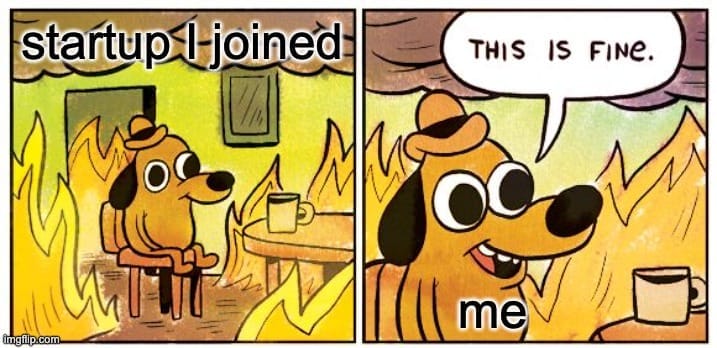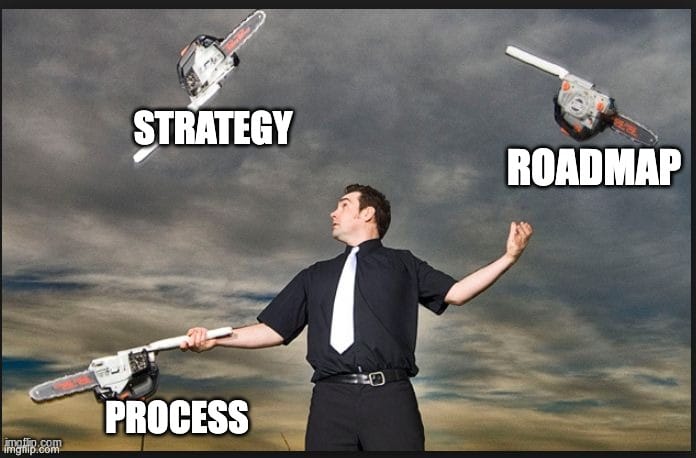ProductFTW #4: Being the First Product Manager
As the product manager, your job is to turn this beautiful mess into a well-oiled machine that can pump out products and features that are so good that customers are ripping it out of your hands.
You’ve gone and done it—jumped headfirst into the chaos of a startup, snagging the role of the first product manager. In this world, order is a myth, the process is a joke, and literally everyone is winging it. It’s a beautiful mess, and learning is less a choice and more a survival instinct. As the product manager, your job is to turn this beautiful mess into a well-oiled machine that can pump out products and features that are so good that customers are ripping it out of your hands. Easy-peasy right? If only.

I’ve had the privilege of being PM #1 a couple of times now, most recently at an early-stage startup called Perigon, where I’m about to hit my first anniversary. I thought it would be a good time to reflect on what I’ve learned and share what to expect in your first year as the inaugural PM in the hopes that I can save someone time and effort, preventing the headaches that I went through. And to be clear, this is just my take– there is no data, no studies, simply the lived experience from someone still in the thick of it.
This will be a two-part series; this first half will focus on the first week and proceeding month as the first PM. Part two will be focused on the next 6-12 months.
Week 1

Get ready to drink from the fire hydrant. Your first week will be overwhelming, messy, and stressful. Early-stage startups will not have a pleasant, informative onboarding experience like you’d expect from bigger companies–and if they do, you should question whether they have their priorities in the right place!
Your sole responsibility this first week is to learn as much as possible. The only way you’re going to do that is by staying organized. Write everything down. Record it, have AI transcribe it, whatever. The things you learn this week will be foundational to everything you do going forward. Chances are, no one has documented anything you’re going to learn this week anyway, so you’re going to be the person who’s going to do that (and every week after that!).
This is not an exhaustive list, but try to focus your first week on learning about the most important aspects of the business. This includes:
- The company mission and vision. You should have some sense of the mission and vision since that’s hopefully what convinced you to join a startup in the first place, but try to spend time with the CEO and founders to dig into this more so you can start off with the right north star. This is also the opportunity to better understand the overall business strategy.
- The team. It takes a village–meet your team and get to know them, what they do, their responsibilities, and how you can help them as the first PM. They will be instrumental in teaching you about the current state of the business.
- The customers. You can’t have a product unless you’re solving a problem for someone. Who are your current customers? What problem are you solving for them? If you don’t have customers yet, what does your ideal customer look like, and why would they use your product?
- The product. The thing you will soon be the expert on and responsible for. What is the main value prop? What are the features? Are there current usage metrics, or is there customer feedback? Is there a roadmap, and what’s on it?
- The tech. How does the product work under the hood? What’s the tech stack, and what are the external dependencies? Is there technical documentation (that’s a joke–of course there isn’t)? How is work currently prioritized and managed?
- The go-to-market. How do people learn about the product? What marketing or advertising is being done?
- Current goals. Are there any KPIs that the business is working towards? What are the teams focused on now? Are there any new features or product launches on the horizon?
That’s a lot to learn in just a few days! Don’t worry, just stay organized. It will get more accessible, and things will start to make sense soon. If you’ve done this right, by the end of the week, you should be able to create a Lean Business Canvas- validate your understanding of the business with the CEO, then go home and have a beer.
The founder/CEO is the original product manager. With you now in the hot seat as the actual product manager, you will need to form a close relationship with them as you help bring their bigger vision to life. This relationship is more than just taking orders; it's about engaging in a constructive partnership where you blend the CEO's strategic foresight with the actual realities of product development. You will ideate, debate, analyze, and measure the success of the product together, and it's ok to push back, offer alternative viewpoints, and give constructive feedback as you build a partnership together. But, at the end of the day, the CEO is your boss. Sometimes, you will have to disagree and commit to a feature or decision you don’t believe in, and that's ok- changes are cheap at this stage of the company. Use data and facts to bolster your case when you are at odds, and more often than not, things will work themselves out.
Month 1

First week down, and you’re still breathing–score! Your first week was ideally a crash course in the business, and you soaked it up like a sponge. The odds are pretty high that everything felt messy and unorganized (except you–you took meticulous notes, right?), so this next month will be focused on fleshing out the product strategy and creating structure through process. Your priorities should generally align with the following:
- Creating the product strategy. Unless the CEO has already created a product strategy (unlikely), you will need to create one. Based on your learnings from Week 1, take a stab at creating a short to medium-term product strategy document that aligns with the company goals (Don’t have company goals? Get with the CEO and create them). This product strategy doesn’t need to be long and complicated right now; just define your target customer, what products or features you will create to solve their problems, and what goals you have for the near to medium term. Like the Lean Business Canvas, validate the product strategy with the CEO, then share it broadly with the company.
- Planning the Roadmap. With the product strategy in hand, you can get tactical and start figuring out what to build. All you need to do right now is stack rank the proposed features- scope and timing don’t matter yet.
- Create structure through process. Process can be a scary word, especially at a fast-moving startup, but it doesn’t need to be. Process right now is simply defining how to communicate within your team. If you can do these 3 things, you’ll be in good shape.
- Align communication patterns with your team. Should you use Slack or Discord? Google meet or zoom? This is the first place to start so that you can collaborate and coordinate on everything else.
- Embrace an internal company documentation tool, like Notion. This is where everyone should now keep documentation like the product strategy, roadmap, requirement docs, tech specs, and more.
- Figure out your SDLC. Work with your design and engineering peers to figure out how things go from idea to requirements to code to a product in the customer’s hands, and then use something like Linear for task tracking. Keep this simple and lightweight.
- Lead by example. Introducing the product strategy, a roadmap, and a process is more than enough to ruffle a few feathers. You must continue to be the most organized person on the team, creating incredible documentation and artifacts, championing any new systems you introduce, and facilitating their adoption. You will have to remind people to adhere to the process constantly. Just don’t be an asshole about it–show them what good looks like by being great.
With these foundations in place, you’re turning the startup mess into a clear game plan, ready to kick things into high gear and make stuff happen over the next few months.
Next week, tune in for part 2, where we’ll turn our attention to the next 6-12 months.
